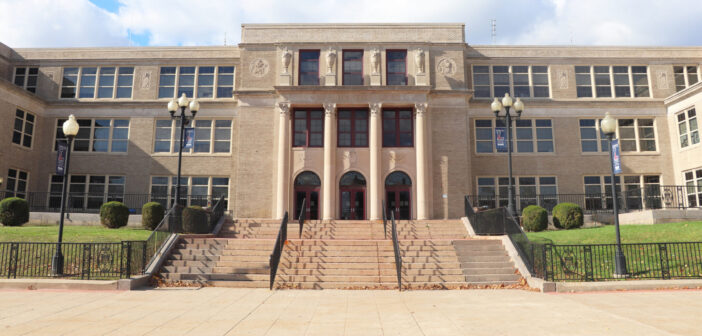Principal Harrison Bailey III used to think of Liberty High School as a lake.
Little streams fed into this lake, stopping and starting depending on the weather. A steady storm season would lead to a full and teeming body of water. But more often than not, drought left the lake parched and baked by the sun.
An adolescent mental health crisis was on the rise in Bethlehem. But seven years ago, student mental health services at local schools like Liberty were still dependent on outside services supported by nonprofits.
Funding for nonprofits ebbs and flows — just like the amount of rainfall per season — causing inconsistency in the services available to students.
Liberty also lacked a solid referral system and a means of evaluating students’ conditions, meaning every student was put on the same path of support.
The few feeble streams filling Liberty’s lake became crowded.
Adolescent mental health crises have been a growing concern statewide and nationwide, but statistics in Bethlehem are particularly troubling. The 2015 Pennsylvania Youth Survey found “staggering” statistics in Northampton County — 34.9% of students reported feeling depressed or sad most days, and 17.1% of students reported strongly debating committing suicide.
Further, the 2016 Community Health Needs Assessment from St. Luke’s University Hospital in Bethlehem found the ratio of the population to the number of mental health professionals in Northampton County to be 592 to 1.
Still, the teenage focus group participants in St. Luke’s assessment indicated a solution: “Schools should be used as an important asset to teach students about positive health behaviors.”
Sometime in 2016, Bailey and his fellow Liberty administrators viewed a TED Talk titled “How Childhood Trauma Affects Health Throughout a Lifetime” by Nadine Burke Harris, the former Surgeon General of California.
Bailey said that one YouTube video changed everything.
“For us, it was a matter of recognizing that we had a significant number of students dealing with some very serious social, emotional, physical and academic problems,” Bailey said. “That, in and of itself, was a huge step because at this point, no one was talking about mental health.”
Acting as a beacon for the rest of the Bethlehem Area School District (BASD), Bailey and his fellow Liberty administrators assembled a committee and began the mission of becoming a trauma-informed “school of wellness.”
With time, money and dedicated staff, the committee blossomed into what is now a district-wide, multi-tiered system of mental health support. Today, this system of social-emotional learning (SEL) is implemented across all 22 schools within BASD, providing every student with the mental health treatment they need and embedding wellness into the curriculum.
Karen Pooley, a director for the Bethlehem Area School Board and Lehigh professor of political science, defined SEL as an approach to teaching that prioritizes students’ social, emotional and behavioral issues in addition to academics.
“Quite frankly, if the social-emotional side isn’t supported, … there’s no hope of getting to the academic side,” Pooley said. “Schools don’t have the luxury of saying, ‘Sorry, we just talk about math here.’”
While SEL extends from kindergarten to 12th grade, its application looks different within elementary and secondary schools.
Claire Hogan, BASD’s chief pupil services officer, said the district’s elementary schools have implemented a program called “Leader in Me,” which teaches children how to become productive citizens. Secondary schools mainly utilize restorative practices that teach students how to build relationships, but she said high school is a different beast within itself.
SEL has replaced a purely academic learning culture.
Restorative practices rethink discipline approaches that don’t give students a chance to learn from teenage mistakes.
And in-school targeted intervention has filled the gap of unreliable outside services.
Nikolas Tsamoutalidis, Hogan’s supervisor who pioneered the tier system that has led to these changes, said the system is modeled in the form of a triangle.
He said Tier 1, the base of the triangle, consists of “core supports,” the quality instruction that every student receives regardless of their mental health.
A tactic within this tier is the two-minute pause: in the transition period between each class during the school day, a voice comes through the intercom system, instructs students to put down their electronic devices and guides them through breathing exercises.
“People think you have to meditate forever in the hills of Tibet,” Tsamoutalidis said. “But, science shows if you battle with anxiety, … just five minutes a day can reduce your anxiety, can push back on your depression and can push back on your ‘stinking thinking,’ as I call it.”
Tier 2 is the “targeted intervention” section. Tsamoutalidis said teens who have support needs beyond the average student can find different forms of counseling with full-time therapists inside the in-school wellness centers.
The wellness centers at both Liberty and Freedom High Schools are home to groups focused on topics like anxiety, depression and vaping. There are groups for LGBTQ+ students, English language learners and students who have lost loved ones. A newer addition is a girls’ conflict group, which was added because administrators witnessed an uptick in girl-on-girl violence as a form of navigating conflict.
Tsamoutalidis said Tier 3, the apex of the triangle, is for students who need one-on-one counseling, psychiatric care or medication. This tier is fueled and sustained by ongoing partnerships with outside services such as Pinebrook Family Services and the Lehigh Valley Health Network.
In May 2023, a 14-question survey was issued to the students receiving mental health treatment within both high schools. Its responses proved the efficacy of the triangle.
In the survey, 92% of respondents indicated the service they’re receiving is improving their positivity and overall emotional state. In response to the prompt, “I’m more hopeful about my future,” 82% of students either agreed or strongly agreed.
On Dec. 4, Tsamoutalidis and Hogan gave a presentation to the school board titled “2023 Quarter One Student Services Update of Secondary Schools.”
One of the celebrations presented was a decrease in the number of high school mental health incidents recorded within the 2021-2022 and 2022-2023 school years. Freedom showed a decrease from 147 to 20 incidents. For Liberty, the number decreased from 352 to 118.
According to the presentation, of the 762 students receiving Tier 3 treatment between 2022 and 2023, only 139 cases were unsuccessful, meaning 81.76% of treatment was either successfully terminated or is still ongoing.
But SEL tactics, even years into their application, can only do so much to stop the mental health crisis in Bethlehem.
There is still a limit to local mental health support. Of the 139 unsuccessful high school treatment cases within the student services Quarter 1 update, 84 ended due to a reduction in therapists.
Also, according to the 2023 Bethlehem Community Health Needs Assessment issued by the Bethlehem Health Bureau, mental health is still the primary concern among high school-aged focus group participants.
The study states 42.1% of local adolescents reported feeling depressed most days in the past year, which is higher than the state average of 38.1%, and 17.4% reported considering suicide, higher than the state level of 16.5%. These statistics are also higher than those reported in St. Luke’s 2016 Community Health Needs Assessment.
One potential reason for the increase was the COVID-19 pandemic, which Bailey said exacerbated mental health problems among students. Hogan also said she’s witnessed students lose the ability to express their feelings, and anxiety has skyrocketed in the wake of the pandemic.
Ultimately, however, the causes for the higher averages in Bethlehem and the increase in mental health issues over time remain unknown. Understanding the upward trend is one of the greatest challenges of this work, Pooley said.
This year’s Bethlehem Community Health Needs Assessment included a “forces of change assessment” that indicated the top forces contributing to local health issues. These included the widening income disparity gap and substandard housing, among others.
But Hogan said the multi-tier SEL system helps eliminate some of those variables and hone in on an individual’s situation.
“If you want to really teach or provide appropriate support, you have to have a true understanding of what that student’s needs are,” Hogan said. “You have to really look at that whole child.”
When looking at the volume of challenges that students are facing, Bailey said the reality is that BASD is never going to have enough services.
However, the inclusion and expansion of SEL has allowed staff and faculty to expand their repertoire of tools to work with students who are struggling with mental health. Today, he knows BASD is situated well enough to be able to do the work.
“Our students are hurting,” Bailey said. “But there was a time period where mental health was taboo and negative. It was kind of a thing that people did in secret.”
But he said the current system has allowed for a crucial change.
Not only are students recognizing their needs and wanting help, they are actively seeking support within their schools.






Comment policy
Comments posted to The Brown and White website are reviewed by a moderator before being approved. Incendiary speech or harassing language, including comments targeted at individuals, may be deemed unacceptable and not published. Spam and other soliciting will also be declined.
The Brown and White also reserves the right to not publish entirely anonymous comments.